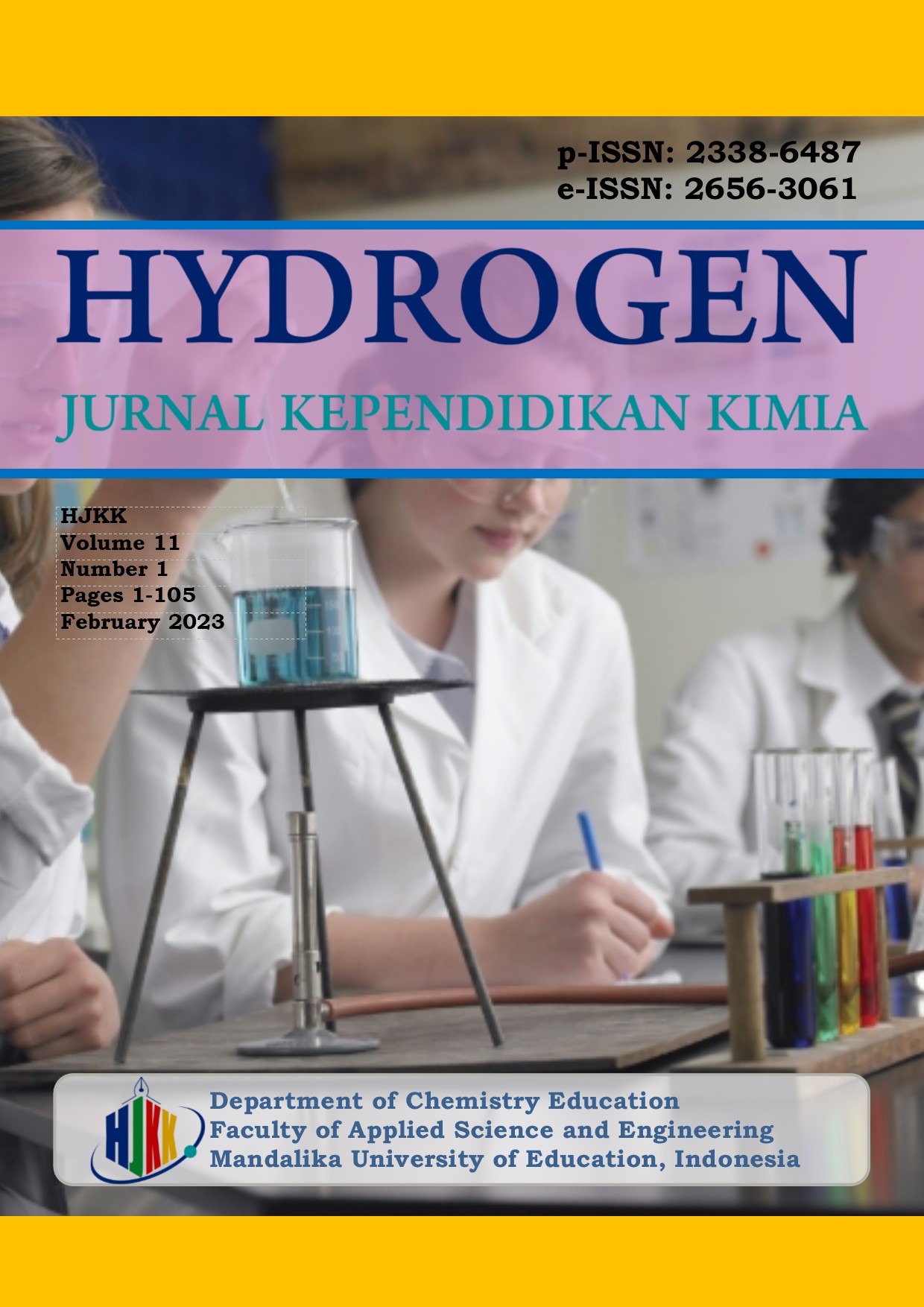Enhancing Students' Oral and Written Communication Skills through Discovery Learning Model: A Study on Reduction-Oxidation Reactions
DOI:
https://doi.org/10.33394/hjkk.v11i1.5592Keywords:
discovery learning, communication skill, redoxs reactionAbstract
References
Andrianie, D, Sudarmin, & Wardan, S. (2018). Representasi kimia untuk mereduksi miskonsepsi siswa pada materi redoks melalui penerapan model pembelajaran inkuiri terbimbing berbantuan LKS. Chemistry in Education, 7(2): 69-76.
Arends, R. (2012). Learning to teach. New York : McGrawHill
Azhari, R. P., & Nurita, T. (2021). Penerapan model pembelajaran discovery learning untuk meningkatkan keterampilan komunikasi siswa. Pensa E-Jurnal: Pendidikan Sains, 9(3). pp. 385-393.
Curran, Timothy P.; Mostovoy, Amelia J.; Curran, Margaret E.; Berger, Clara (2016). Introducing Aliphatic Substitution with a Discovery Experiment Using Competing Electrophiles. Journal of Chemical Education, 93(4):757-761. https://doi.org/10.1021/acs.jchemed.5b00394
Ertikanto, C., Rosidin, U., Distrik, I., Yuberti, Y., & Rahayu, T. (2018). Comparison of Mathematical Representation Skill and Science Learning Result in Classes with Problem-Based and Discovery Learning Model. Jurnal Pendidikan IPA Indonesia, 7(1), 106-113. doi:https://doi.org/10.15294/jpii.v6i2.9512
Harlen, W. (2006). Teaching, learning and assessing science 5-12, London : SAGE Publications.
Kristini, E. (2021). Penerapan metode discovery learning dengan pendekatan adiksimba untuk meningkatkan ketrampilan bertanya dan hasil belajar pendidikan kewarganegaraan. Journal of Education Action Research, 5(3), 309–317. https://doi.org/10.23887/jear.v5i3.33109
Kulevich, Suzanne E.; Herrick, Richard S.; Mills, Kenneth V. (2014). A Discovery Chemistry Experiment on Buffers. Journal of Chemical Education, 91(8), 1207–1211. doi:10.1021/ed400377a
Larson, L.C & Miller, T.N. (2011). 21st Century Skills: Prepare Students for the Future. Kappa Delta Pi Record, 47(3), 121–123. doi:10.1080/00228958.2011.10516575
Marfuah. (2017). Meningkatkan Keterampilan Komunikasi Peserta Didik melalui Model Pembelajaran Kooperatif Tipe Jigsaw. Jurnal Pendidikan Ilmu Sosial. 26(2): 148-160.
Meikasari, D. Rosilawati, I. dan Tania, L. 2020. Efektifitas Model Pembelajaran Guided Discovery pada Materi Kesetimbangan Kimia dalam Meningkatkan Keterampilan Komunikasi Siswa. Jurnal Pendidikan dan Pembelajaran Kimia, 9(2). Hal 60-80
Melawati, C., Paristiowati, M., & Suhartono, S. (2014). Analisis kemampuan komunikasi dan kerja sama siswa pada pembelajaran kimia melalui model pembelajaran kooperatif tipe TAI (Team Assisted Individualization). Jurnal Riset Pendidikan Kimia (JRPK), 4(1), 251 - 259. https://doi.org/10.21009/JRPK.041.04
Nurmala, R.S & Priantari, S. (2017). Meningkatkan keterampilan komunikasi dan hasil belajar kognitif melalui penerapan discovery learning improving communication skills and cognitive study result through discovery learning. Bioma : Jurnal Biologi dan Pembelajaran Biologi, 2(1). doi:https://doi.org/10.32528/bioma.v2i1.586
Qadariyah, L dan Hendriana, H., 2015 Mengembangkan Kemampuan Komunikasi dan Disposisi Matematik Siswa SMP Melalui Discovery. Edusentris Jurnal Ilmu Pendidikan dan Pengajaran, 2(3): 241-252. https://doi.org/10.17509/edusentris.v2i3.177
Rahayu, I. P., & Asri Hardini, A. T. (2019). Penerapan Model Discovery Learning untuk Meningkatkan Keaktifan dan Hasil Belajar Tematik. Journal of Education Action Research, 3(3), 193–200. https://doi.org/10.23887/jear.v3i3.17369
Ramadini, A., & Linda, R. (2022). Kesulitan belajar pada materi pelajaran reaksi reduksi dan oksidasi siswa SMA. Prosiding Seminar Nasional Pendidikan Kimia, 1(1), 61–65. Retrieved from http://proceedings.radenfatah.ac.id/index.php/snpk/article/view/54
Santika, A.D., Rudibyani, R.B., & Efkar, T. (2016). Penerapan discovery learning dalam meningkatkan kemampuan berpikir luwes materi elektrolit/nonelektrolit. Jurnal Pendidikan dan Pembelajaran Kimia. 5(3):143-155.
Slavin, R. E. (2010). Cooperative Learning Teori, Riset dan Praktik (Terjemahan). Bandung : Nusa Media
Sugiyono. (2019). Statistik untuk Penelitian. Bandung: Alfabeta.
Sumendra, M. Y. (2021). Aktivitas dan hasil belajar peserta didik pada implementasi online discovery learning. Journal of Education Action Research, 5(1), 48–56. https://doi.org/10.23887/jear.v5i1.31019
Van Laar, E., van Deursen, A. J. A. M., van Dijk, J. A. G. M., & de Haan, J. (2020). Determinants of 21st-Century Skills and 21st-Century Digital Skills for Workers: A Systematic Literature Review. SAGE Open, 10(1). https://doi.org/10.1177/2158244019900176
Yuniarti, E., Bahar, A., & Elvinawati, E. (2020). Analisis miskonsepsi siswa pada materi konsep redoks menggunakan Certainty of Response Index (CRI) di SMA Negeri 9 Kota Bengkulu. ALOTROP, 4(1). https://doi.org/10.33369/atp.v4i1.13714
Yusefni, W. (2015). Implementasi Pembelajaran IPA Terpadu menggunakan Pendekatan Science Writing Heuristic (SWH) untuk Meningkatkan Penguasaan Konsep dan Kemampuan Berkomunikasi Siswa SMP. Tesis S2. Sekolah Pascasarjana, Universitas Pendidikan Indonesia.
Downloads
Published
How to Cite
Issue
Section
Citation Check
License
License and Publishing Agreement
In submitting the manuscript to the journal, the authors certify that:
- They are authorized by their co-authors to enter into these arrangements.
- The work described has not been formally published before, except in the form of an abstract or as part of a published lecture, review, thesis, or overlay journal.
- That it is not under consideration for publication elsewhere,
- That its publication has been approved by all the author(s) and by the responsible authorities – tacitly or explicitly – of the institutes where the work has been carried out.
- They secure the right to reproduce any material that has already been published or copyrighted elsewhere.
- They agree to the following license and publishing agreement.
Copyright
Authors who publish with Hydrogen: Jurnal Kependidikan Kimia agree to the following terms:
- Authors retain copyright and grant the journal right of first publication with the work simultaneously licensed under a Creative Commons Attribution License (CC BY-SA 4.0) that allows others to share the work with an acknowledgment of the work's authorship and initial publication in this journal.Â
- Authors are able to enter into separate, additional contractual arrangements for the non-exclusive distribution of the journal's published version of the work (e.g., post it to an institutional repository or publish it in a book), with an acknowledgment of its initial publication in this journal.
- Authors are permitted and encouraged to post their work online (e.g., in institutional repositories or on their website) prior to and during the submission process, as it can lead to productive exchanges, as well as earlier and greater citation of published work.
Licensing for Data Publication
Hydrogen: Jurnal Kependidikan Kimia uses a variety of waivers and licenses, that are specifically designed for and appropriate for the treatment of data: Open Data Commons Attribution License, http://www.opendatacommons.org/licenses/by/1.0/ (default) Other data publishing licenses may be allowed as exceptions (subject to approval by the editor on a case-by-case basis) and should be justified with a written statement from the author, which will be published with the article.







